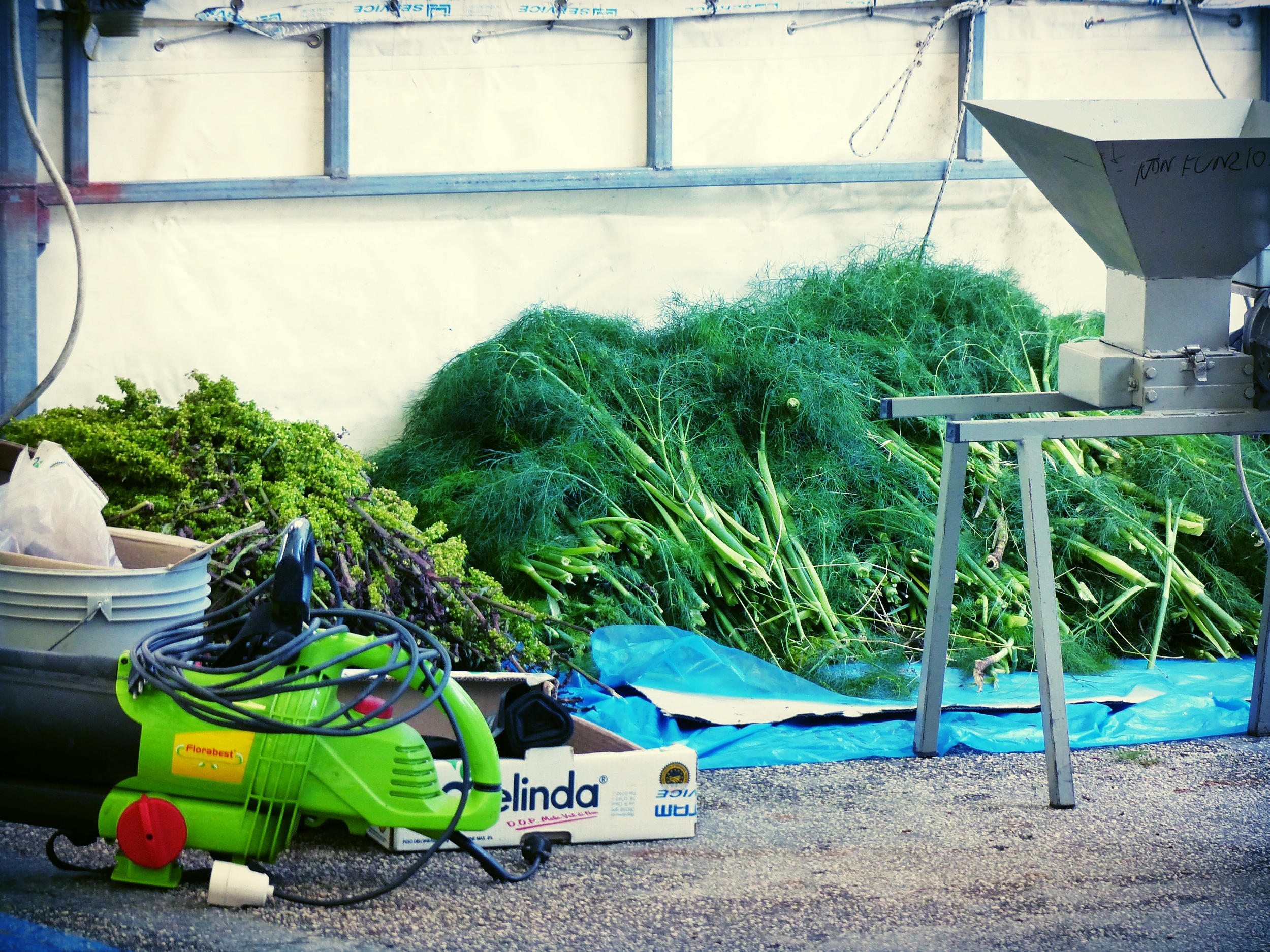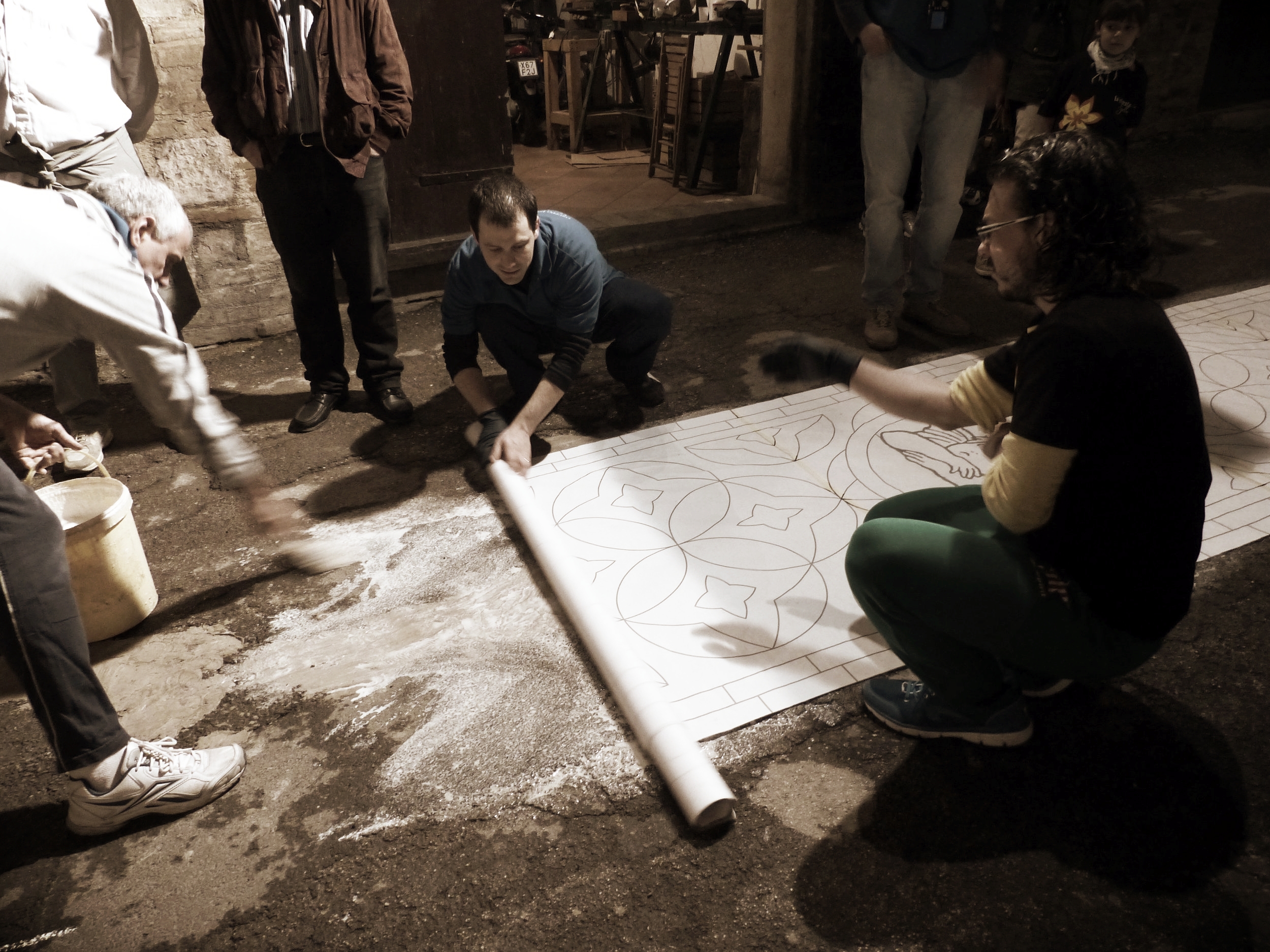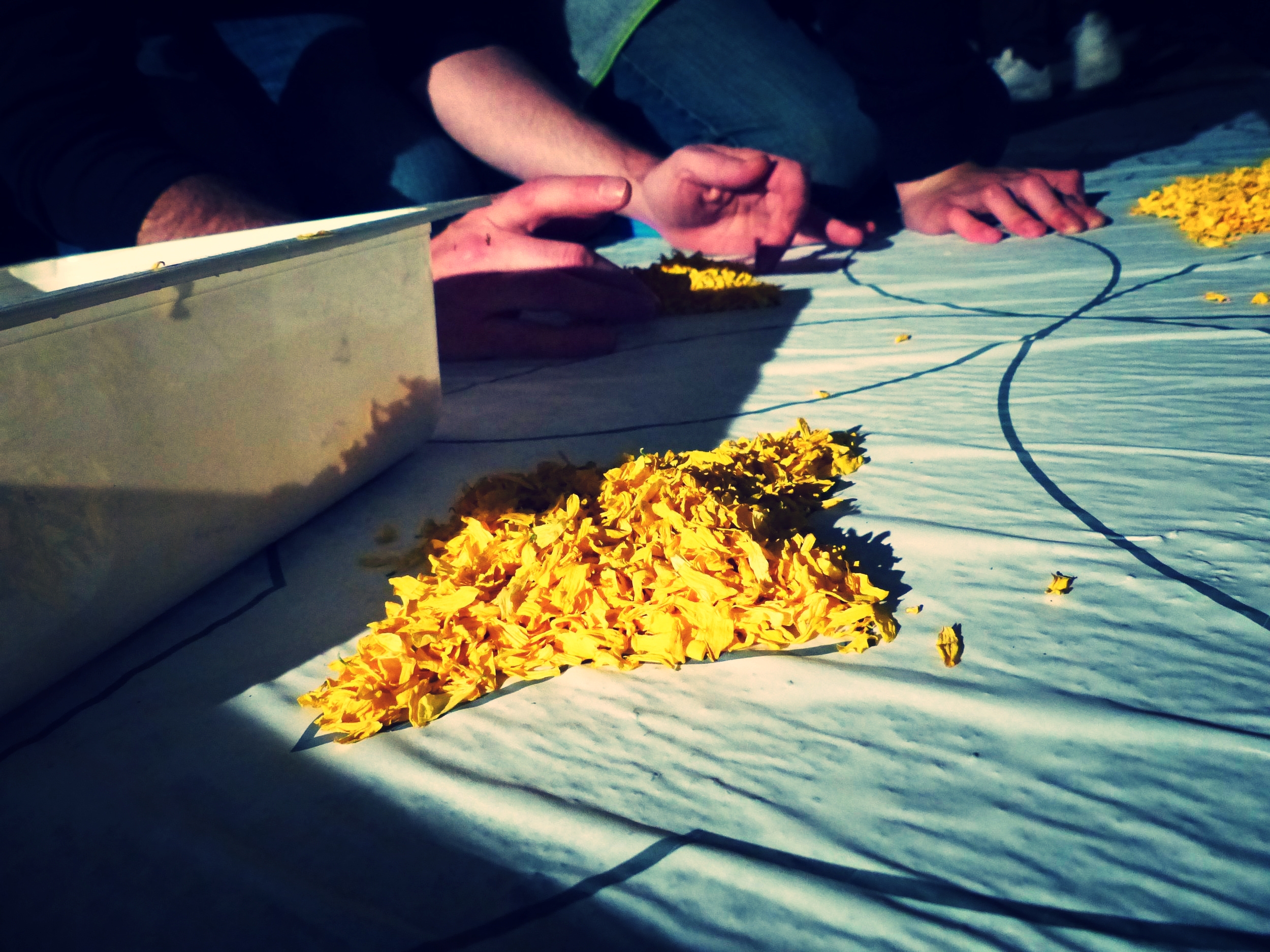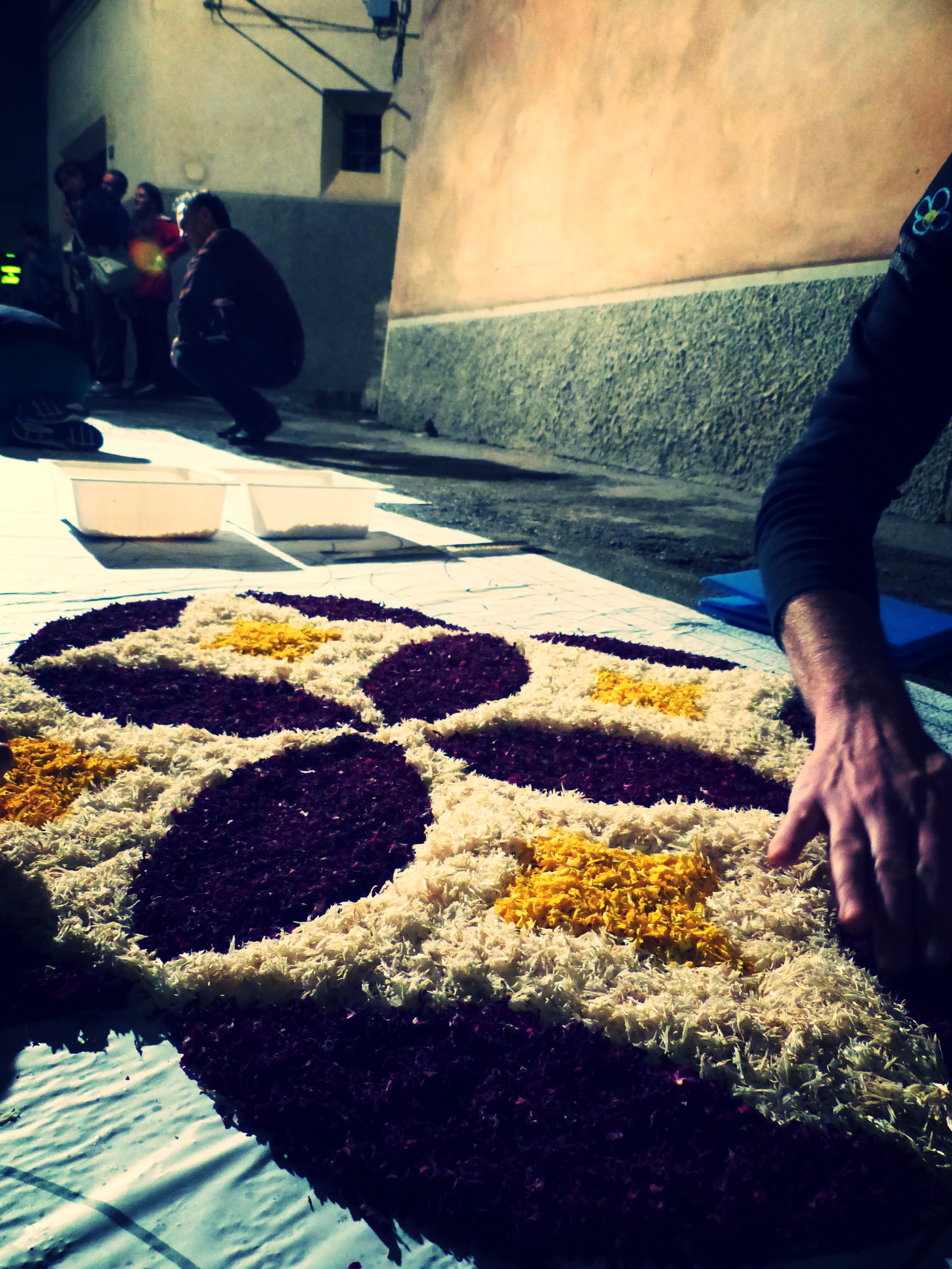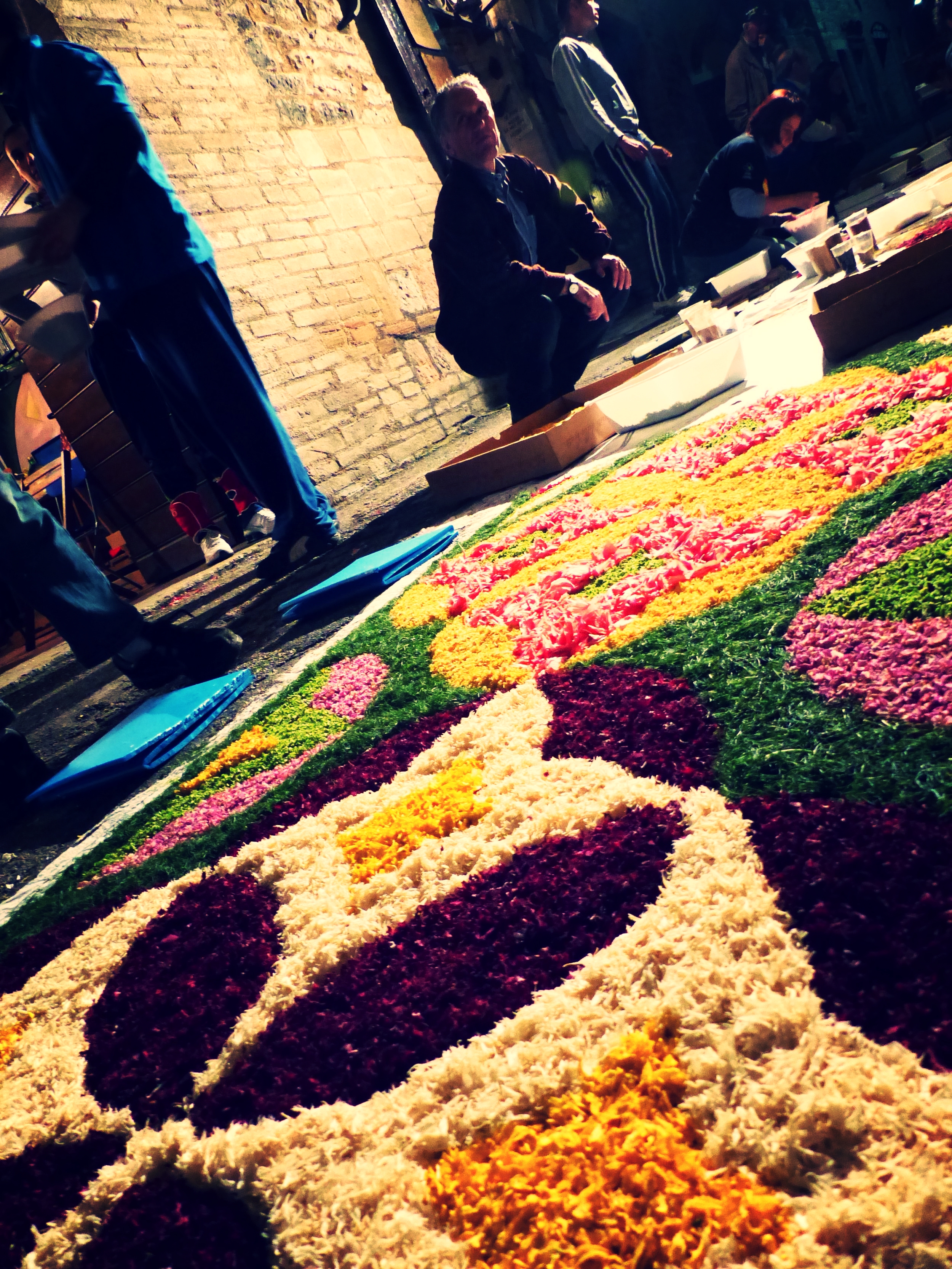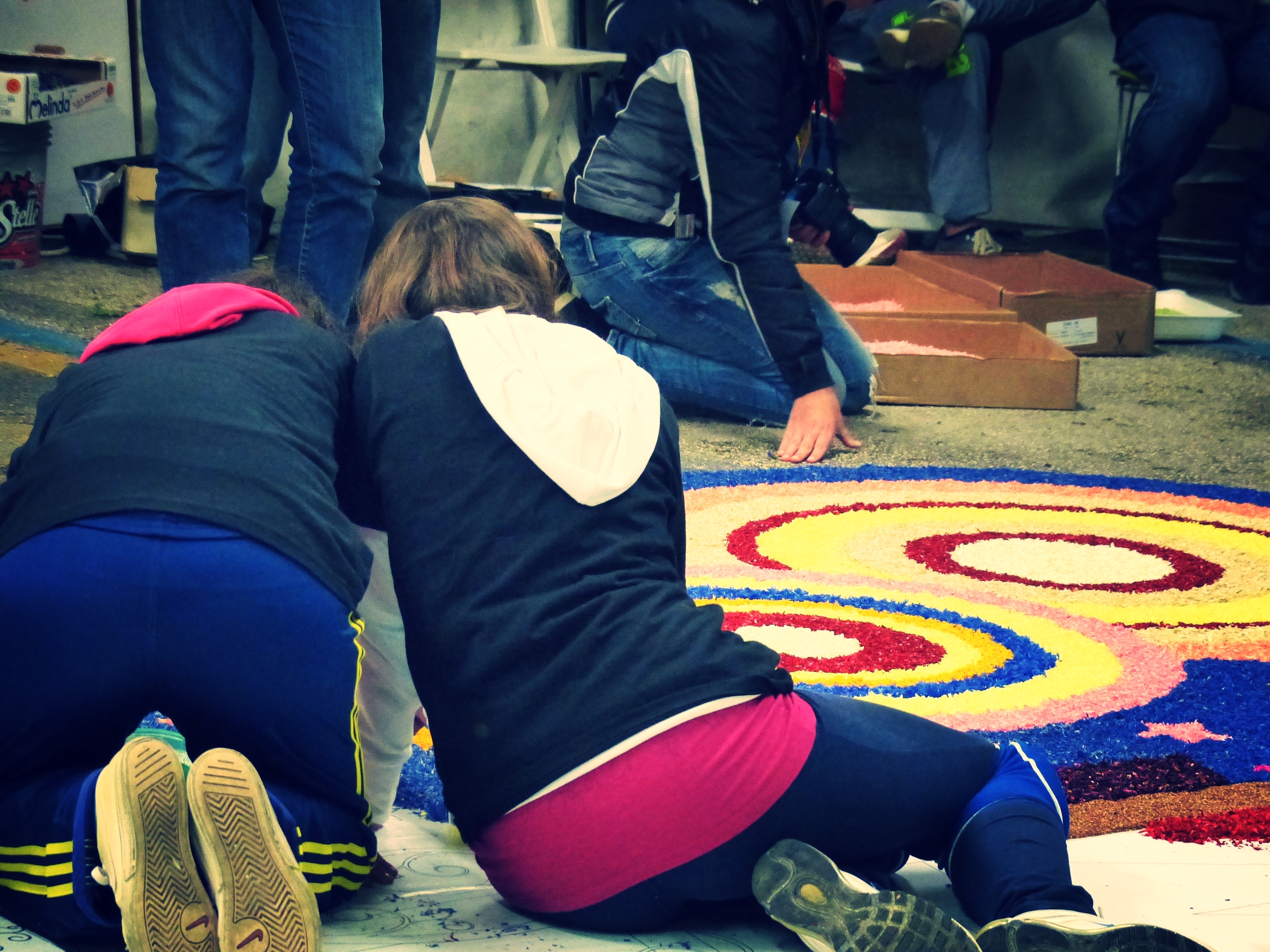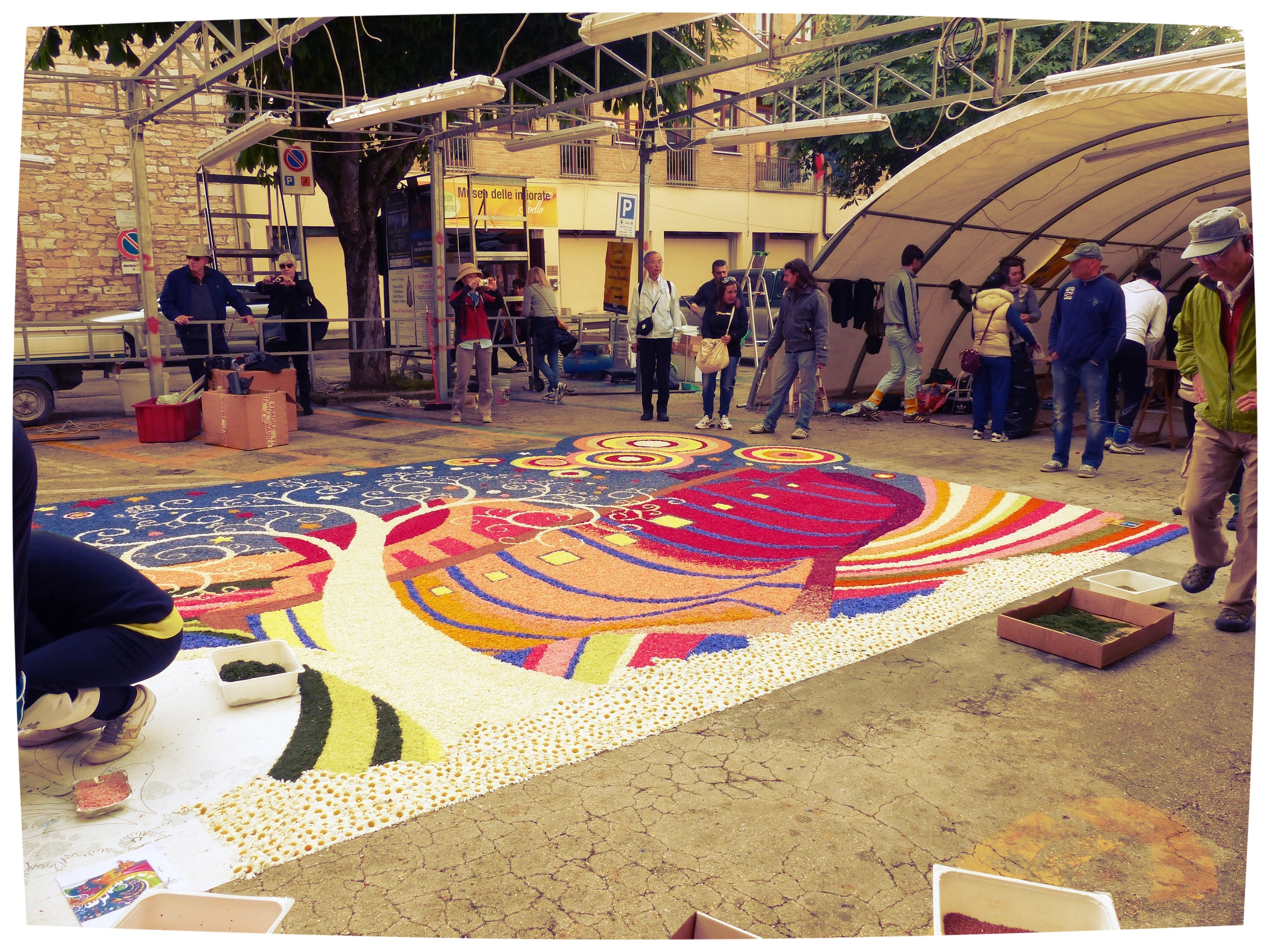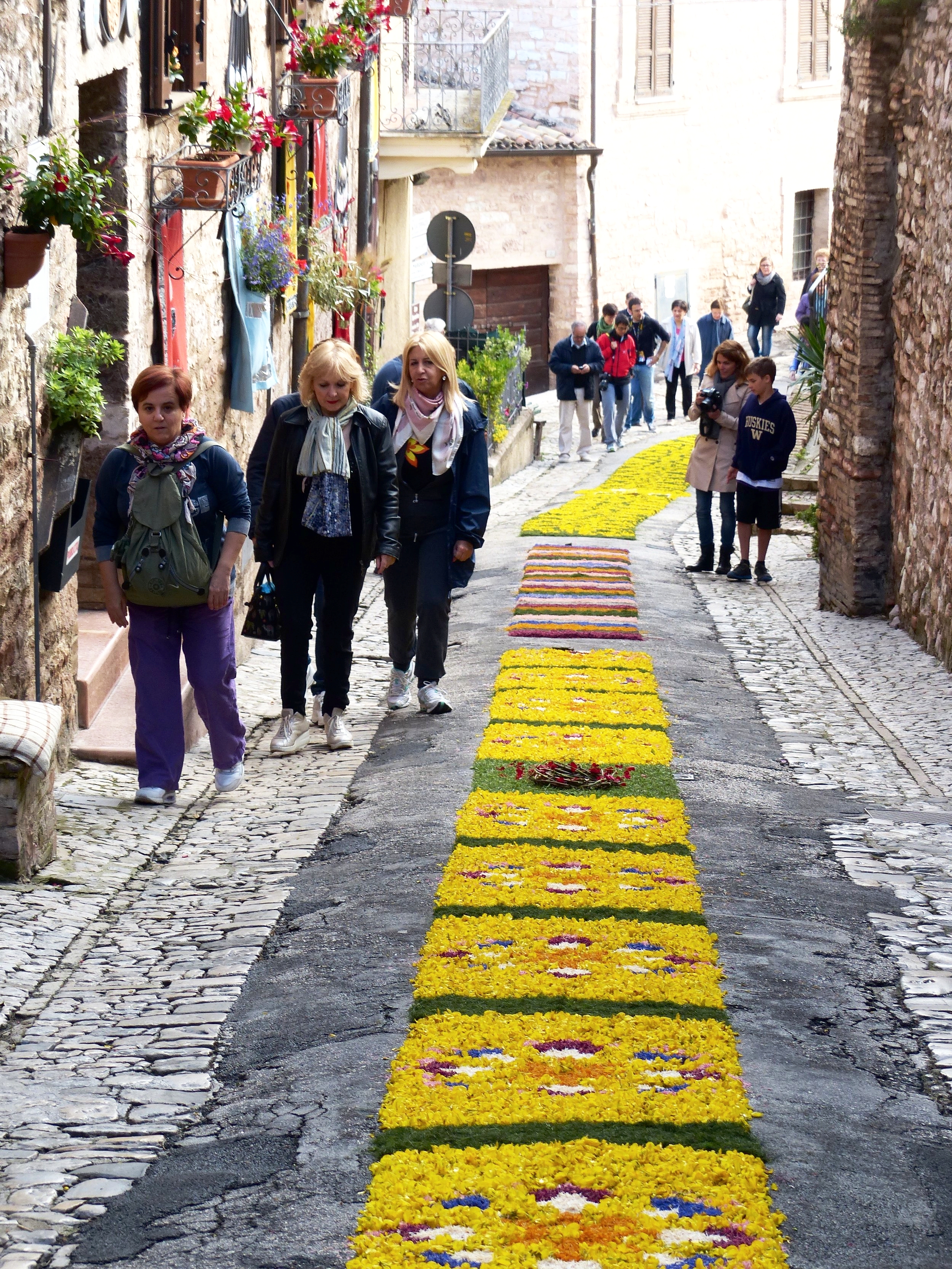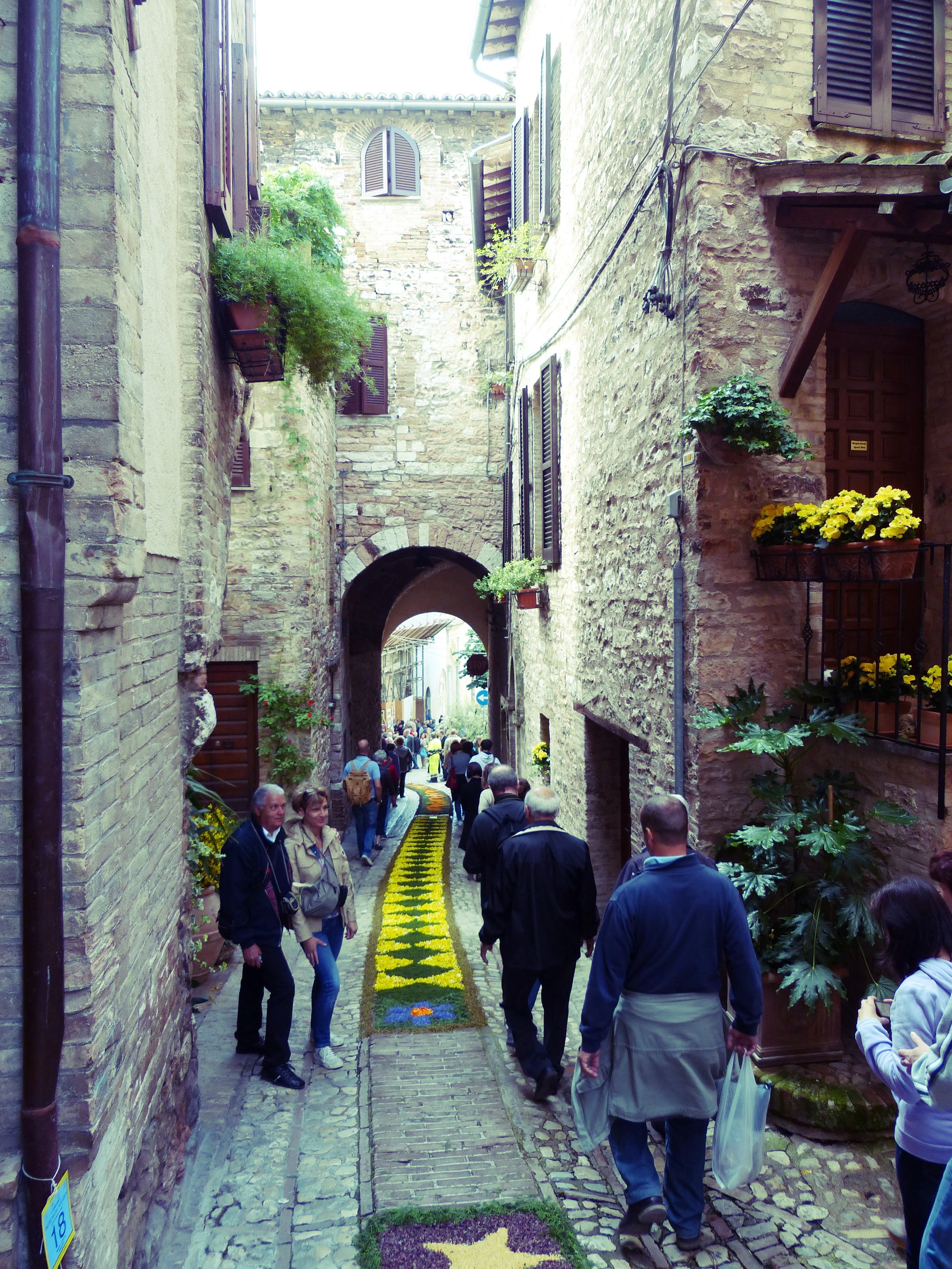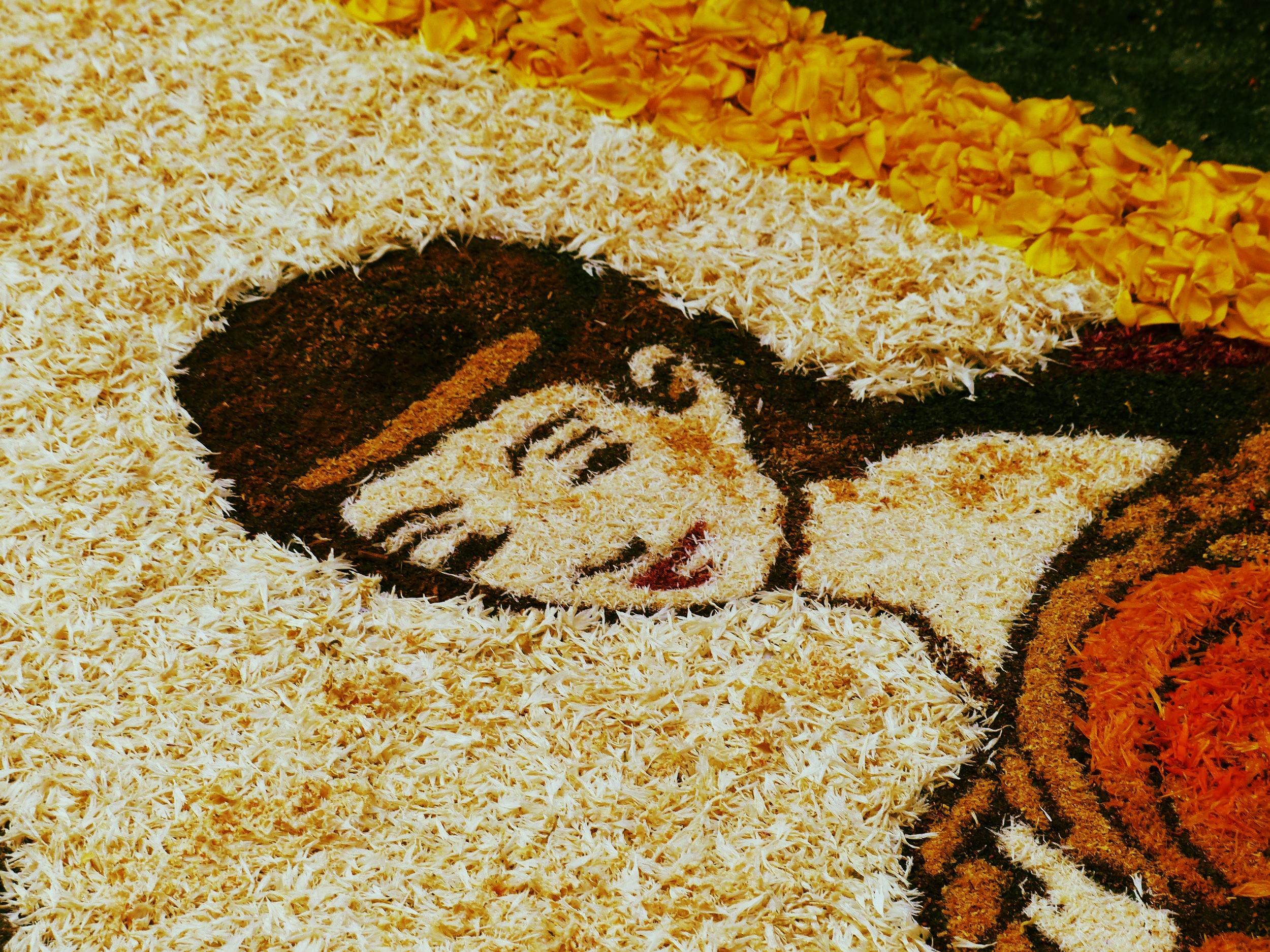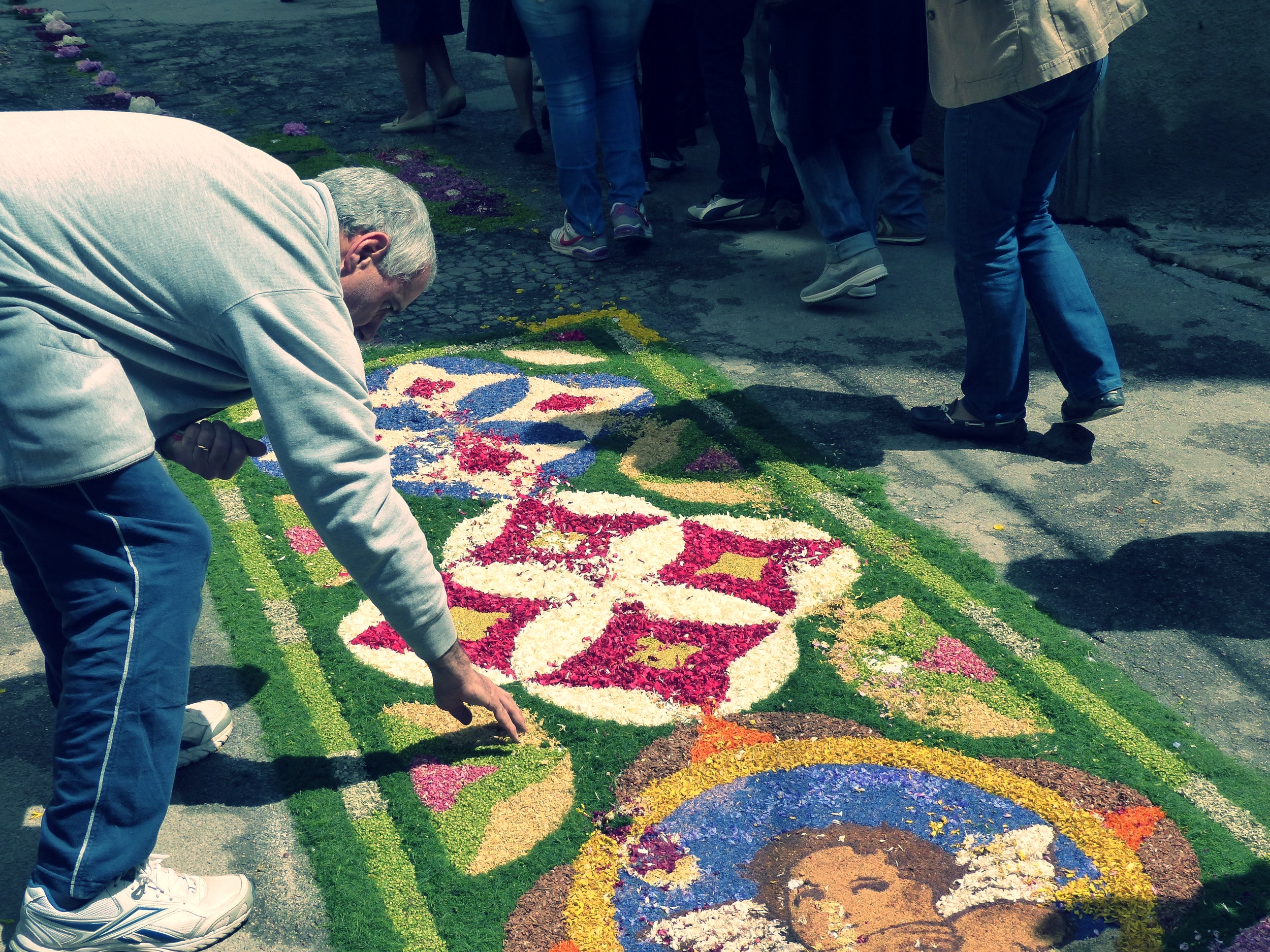Spello's Infiorata
/Note: This post is a modified excerpt from "Il Bel Centro: A Year in the Beautiful Center", but with all the photos I wish I'd been able to include (get your own e-copy of the book here or for other versions, including print, click here). The images are captioned for details.
The weather is the main topic of conversation in Spellani bars. Is it raining, will it rain, how hot will it get, where is the weather nice, who knows a catchy proverb that fits with our meteorological events? It is a particularly hot topic now, as the town gears up for the Infiorata. The festival is Spello’s most beloved tradition, and her residents hold their collective breaths in hopes that nothing will go wrong. Everywhere, people are compulsively stepping outside to glare at the sky. There is a constant bemoaning of the diminished flower growth this year, the result of perpetual drizzle which has shackled sunlight. Any respite from the rain results in a flurry of neighbors potting, trimming, and cleaning. Gussying up the town for the onslaught of visitors. The Infiorata is celebrated up and down the Boot, but in few places with as much fervor and pride as this little town in Umbria. It is flower hysteria in Spello.
Saturday morning of the Infiorata dawns drizzly, but it begins clearing by afternoon. Voices that were hushed and tense now take on a more characteristic lightness. Tents start popping up over the sites of the quadrati—the large, mural-like works, which are judged separately from the tappeti, the longer runs of flowers. According to the rules of the competition, the laying of flowers cannot begin until late at night. I watch teams feverishly vacuuming and drying the wet streets, creating masonry barriers to divert rain around the work, laying down the design templates or using chalk to draw a grid and transfer the image to the street square by square. Spello is burbling with conversation as adults and children sit on plastic chairs lining the streets, removing petals from flowers and placing them into shallow boxes.
As we stroll down Via Giulia, we are hailed by Riccardo. I’m surprised he remembers us from Barbara’s party back in December. He pulls us into a cantina lined with boxes of petals, and then hands us a slip of paper emblazoned with Raphael's Madonna and Child. It’s their tappeto design, he tells us with irrepressible pride. He hands each of our children a juice box and orders us to return at 9:30 PM to begin work. Keith and I consult with each other wordlessly. Yes, we will join Riccardo’s Infiorata group. What this means we’ll be doing, I don’t know, but I find I’m impatient to find out. I’m willing to lay some masonry or copy chalk grids onto the street to be part of this.
The street buzz is so infectious, we have to force ourselves indoors for dinner. Over our new taste sensation—homemade pizza with dabs of ricotta and salsa tartufata, we process the alteration in our expectations. We had pictured observing the activity, now we’ll be part of it. Another passeggiata takes us past Paola’s shop, which is still open. Paola tells me that all the shops will be open until past midnight. The bars will be open until 2:00 AM. To accommodate the masses, there are tables and chairs set up in the area usually given over to the school. We sit and try to eat our cups of gelato, but we’re too excited. Nicolas, it should be said, finds a way to finish our leftovers. He’s hearty that way.
Gelato consumed, we amble to the cantina to join what I can now call our Infiorata group—Pochi, ma Buoni. The Few, but Good. We’re introduced to a welcoming collection of Spellani who are energized for the night ahead. The maestro—the one in charge of directing the night’s work—is Sauro, the baker. I wonder if this means there are baked goods in my future.
Our first step is to remove the tiny pods from the inner cores of daisies, while making conversation with other workers and fielding questions about how six-year-old Gabe speaks effortless Italian. Our other kids speak it just as well to our ear, but Spellani are adamant that Gabe has nailed it.
Once finished with our flower work, Nicolas leaves to visit his friend Mario, who is working on a design in the piazza for the middle school, while the rest of us stand in the street and watch as Sauro and Riccardo patch potholes and then slather wallpaper paste onto the asphalt to lay down the paper printed with a Rafael design. The rules stipulate that the template must not be colored, so groups indicate the colors to be laid in each section by number, color name, or flower name. With Pochi, Ma Buoni, there are no color indications on the design, just a hand-held mock up of the image. Sauro determines which flowers to lay based on the abundance of each type of flower. The petals themselves are not allowed to be glued to the surface. They can be sprayed with water to keep them fresh, which keeps the petals safe from errant breezes, but they cannot be adhered in any way.
Some groups use store-bought flowers, evidenced by the plastic wrapped bunches of bright carnations. But Pochi, Ma Buoni only uses flowers gathered by group members, from gardens or in the wild. Some petals are dried to intensify their color, some are cut into pieces or ground up, others are processed at the last minute so they stay fresh and vibrant. Every group waits for the sun to set before chopping fennel. The licorice scent of the green fronds filling the streets and alleys will forever remind me of the Infiorata.
The group provides a design for children to work on as they please, and Gabe and Siena join the bambini, until work begins on the main design. Completely contrary to our low expectations of what we’d be allowed to do as novice infioratori, our family is given an entire segment of the design to complete together. I’m not sure we’re ready for this level of responsibility. But I take comfort in Sauro’s consistent supervision. He’s constantly walking the length of the template, running upstairs to look down on the progress, and advising adjustments. The five of us sit down to work, laying flowers as dictated by the baker. I’m not surprised at Siena’s engagement—handicrafts and flowers are her sustenance—but Gabe’s focused concentration and Nicolas’s investment in spending hours putting flowers between lines of a template both amaze me.
Nicolas’s friends walk by at 11:30 and invite him on a passeggiata to see the progress of the other groups. He brushes off his knees and leaps to join them, which means he misses the dinner that is served at midnight, penne with wild asparagus and sausage. Luckily, he had all that gelato. As we eat, Riccardo shows me a photo of himself with a massive armload of the freshly collected asparagus. Nicolas rejoins us shortly after we return to work, and is present for our next break of hand-cut, homemade prosciutto, salumi, homemade wine, and pastries.
When we run out of the petals we’re using to fill in a section, Siena dashes into the cantina to ask for more. Riccardo is omnipresent, taking Gabe for walks when his knees hurt from kneeling, or pressing another piece of Nutella cake into our free hands. Barbara is a flurry of motion herself—leading the children to her house for bathroom breaks, assisting in putting out the boxes of flowers. And we all talk and laugh and sip the espresso handed to us with a smile and a wink, as we work alongside our neighbors late into the cool night. Standing to relieve our knees, we watch the maestri bring the human figures in Rafael’s painting to life. With their cups of seeds and pulverized petals like an artist’s palette, in their meditative zone, delicately shading and layering. The figures look just like the painting, which I didn’t expect to be possible with plant matter.
Petals all laid, we are handed a box of newly chopped fennel for the border. It’s pliable, almost like clay and holds the flowers in place. After the large pink petals, which squirmed and shifted so much that Sauro awarded us dieci e lode, ten and praise, the easily matting fennel is a relief. It also pulls the whole design together. We stand back and breathe it in—the scents of fennel and jasmine-like broom mingled with aromas of espresso, the laughter, the flurry of activity getting more food and drinks to infioratori, the inky night patterned with worklights, and the art coming into fruition at our feet. I yawn, and hoist Gabe up so his nodding head can rest on my shoulder. It’s 2:00, and we are released to go home. As we walk through the darkened alley, I send up a prayer that the weather holds.
Slumber doesn’t come easily. Still jittery from the espresso thrust into my hand at 1:00 AM, my snippets of sleep are clouded with dreams of dropping flower petals. Too early, we wrestle ourselves out of bed and back onto the street. Infioratori are still feverishly working on the quadrati, desperate to finish before the judging begins, and the procession later in the morning. Most are nearing completion, and I’m enthralled at the intricate realism of the faces, the creativity of the designs, the boldness of the patterns, and the texture variations created by the petals and whole flowers. The quadrato of Noah’s Ark captivates me with its swirling, elaborate design. We pass images of Saint Francis alongside the new pope, a fanciful rendering of Spello by the middle schoolers, and a modern day Madonna and Child, with long stretches of tappeti between them. The borgo boasts the largest and most complicated designs, with large petals placed as bird feathers and calla lilies used as butterfly bodies.
Once we have toured all the streets full of quadrati and tappeti, we return to Via Giulia to rejoin Pochi, Ma Buoni. As we approach, one of the team members stops in the street and holds our eye contact. Then he deliberately makes two gestures in succession—the slow thumb down the cheek for bella, beautiful, and then the moving of an okay symbol across the body as if pulling a string for ottimo, excellent. And it is. We can’t stop looking at it. Riccardo invites us upstairs to view the complete work from above, and we are speechless. Back down the steps, I ask Riccardo when they had finished, and he replies, a half hour ago. I didn’t count on how long all those fine details would take. Sauro spots us through the crowd and chuckles at our incredulous expressions. He moves toward us and tells us about the rain that had sent Barbara running home for tarps that volunteers had stretched over the workers. We'd sometimes felt light drops as we'd worked, but we'd loudly denied their existence or proclaimed that the moisture would hold down the petals. Tourists filing by had paused over our work and asked “E, se piove?” And, if it rains? I always answered, ”Non lo so,” I don’t know. Though Barbara told me she’d asked the same question many Infiorati ago, and was told, “It’s okay if it washes away. God saw it.”
We breakfast on baked goods the women order us to take, while we walk the perimeter of the design, pausing continually by “our section.” As we wait for the procession to begin, we spy a careless tourist step into the fennel border. Nicolas flies to the tappeto to repair the damage, Siena running to fetch fennel from within the recesses of the cantina. Riccardo, though, is sanguine, joking with the tourist that her multa would be €500. His laughter adds to the carnival atmosphere, further heightened as friends pass to admire the work. Finally, we hear music floating up the hill, from the procession, which begins at Santa Maria Maggiore. Musicians and church members, some holding aloft gold flags, and then the priest, the first allowed to walk on the carpets of flowers. Goosebumps rise on my arms as I watch his feet scatter the petals our group had worked all night to place. It is no longer perfect, but in the eyes of the observant, now it is sanctified. And the thought of holiness taking the form of disruption, rather than perfection, gives me shivers.
We leave after the procession to make lunch, though we should have stayed—Barbara later tells us they brought out homemade lasagna and porchetta. We nap and then saunter out for popsicles at Bonci. I notice that all the vendors light up when they see us—I think with so many strangers, they thrill to a familiar face.
Keith and Siena decide to go to the flower vendors set up in the park, and I take the boys home. Some of our neighbors, including Anna, are sitting on the steps of the alley, and as Gabe overhears they are talking about cats, he calls over the ledge of the terrazza, "I nostri gatti sono grassi.” Our cats are fat. Too true. The group breaks into peals of laughter, and begs him to join them. When I peek out ten minutes later to see him casually sitting with the adults, they call me down for a un vetro, a glass. They pour me a bubbly red wine, and though I catch very little of the conversation, and contribute even less, I’m glad to be included in this informal neighborhood assembly. Gabe leans against me and whispers, “Mamma, I love this.”
At night, as I fall into what feels like a well-earned slumber, I listen to the the melody of hail tip-tapping on the rooftops. Drifting into an easy sleep, I imagine water and ice wending a tangled river of petals down the cobblestone streets to the borgo. When I yawn my way downstairs in the morning, I find Gabe on the couch reading Italian comics. I pull him onto my lap, and he muses that the Infiorata was the most exciting day of his life. I’m not surprised. The vividness of scents and sights, the race to the finish, the turning familiar streets into canvasses, the festival vibe. And the art. The Infiorata is emblematic of Spello’s commitment to the pursuit of art. Not just for rarified individuals, but for everyone. Even six-year-old expats.
Gabe murmurs that he’s hungry, so I decide to walk to the forno for cornetti and boxes of apricot juice. I slip on my shoes, and moments later I step in the bakery, inhaling the now familiar scent of almonds and flour. Sauro calls me from the baking room, and when he catches my attention, he holds his index finger aloft with a grin. It takes me a moment to understand, and then I cannot believe it. We won. Pochi, Ma Buoni won first place in the tappeti competition. He laughs in delight as my jaw drops, and we whoop and applaud each other, while customers look at us curiously, before selecting bread for another day in Spello.
Want more insights into Italy? Sign up for my once-monthly newsletter, the Grapevine, and you’ll not only get wanderlust stories, you’ll be the first to know about new recipes and book deals! Plus, as a welcome gift for joining our Grapevine community, I’ll send you a free e-copy of my bestselling novel, Santa Lucia. Imagine that, in just a few keystrokes, you can escape to Italy!








